Flight Review in a Cubcrafters Top Cub
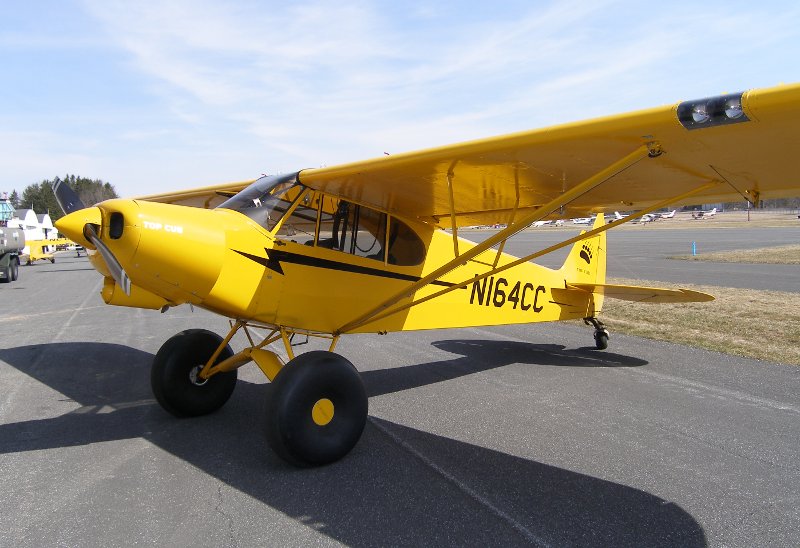
Tired of the usual flight review? Then do what I did.
Hop in a tailwheel airplane and learn how to fly all over
again.
All pilots are subject to a biennial flight review and in March of 2010 I found myself in need of one. Rather than do the same old stuff in the Skyhawk I decided to spruce things up and get back into a tailwheel airplane. I received my original tailwheel instruction in the Mudry Aviation CAP10B and Grob G109B motorglider back in college and, after a short stint towing gliders combined with a half hour in a J-3 Cub to do my spin certification in preparation for my CFI, managed to acquire about 50 hours of tailwheel time. But, of course, that was a long time ago so I expected this to be a challenge akin to learning to fly all over again.
Fortunately, I'm a mere 35 minute flight from one of the best known schools on the east coast for tailwheel instruction: Andover Flight Academy located at Aeroflex Airport in Andover, New Jersey. Among owner Damian DelGaizo's claims to fame was that he trained Harrison Ford to fly tailwheels in preparation for filming Six Days, Seven Nights, but I have to admit the thing that most attracted me to the school was the chance to fly something I'd never flown before -- the Cubcrafters Top Cub equipped with a 180HP engine, flaps capable of 55 degrees, and tundra tires. I scheduled the flight for a Saturday and by the luck of the draw the weather turned out to be the best of the early Spring season with above average temperatures in the 60's and light winds. In other words, ideal tailwheel training weather.
Map Reading
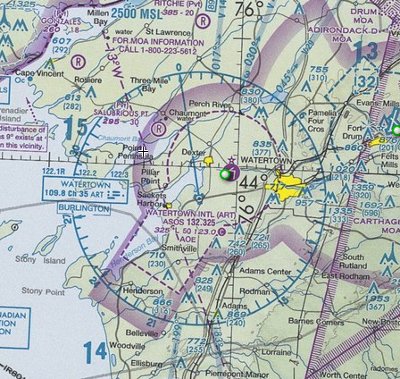 All
flight reviews consist of a minimum of an hour of ground and an
hour of flight instruction. Most CFIs, myself included, spend
time talking about airspace so that's how Damian began the
review. But since Damian teaches bush flying it came as no
surprise that he focused on the stuff that many people who fly in
the lower 48 don't think about regularly.
All
flight reviews consist of a minimum of an hour of ground and an
hour of flight instruction. Most CFIs, myself included, spend
time talking about airspace so that's how Damian began the
review. But since Damian teaches bush flying it came as no
surprise that he focused on the stuff that many people who fly in
the lower 48 don't think about regularly.
We first discussed flying VFR (legally) in low visibility through selected airspace. We looked at a non-towered airport in western New York state that was surrounded by the classic "keyhole" shaped Class E surface area. This airspace requires 3 miles visibility for VFR even when flying at 500 feet AGL (which I believe is the maximum authorized altitude for a cub...correct me if I'm wrong) so the only way to fly in Class E with less than 3 miles visbility or the prescribed cloud clearances is under Special VFR (SVFR) clearance. The question of the day was "if there's no tower or nearby approach / enroute facility to call for SVFR clearance or it's not obvious who to call from either the chart or the AF/D, who do you call?" The answer: our friends at Flight Service, via either a telephone before the flight or in the air via a remote communications outlet (RCO). They will obtain the clearance from the controlling authority and relay it to you. This will separate you from any IFR flights in the area.
We also discussed simple but potentially obscure stuff like the fact that an asterisk next to the "L" (lighting) symbol in the airport description doesn't by default mean that the lighting is pilot controlled but rather that it is not illuminated continuously from dusk till dawn and may be activated via one of several alternate means. If radio-activated pilot controlled lighting is not available the process to activate the lights usually involves calling the airport operator and saying "Hey, can you flick the breaker on the lights? I'll be in at 10PM". I admitted at this time that I'd never been into an airport that required a phone call to active the lighting since I started flying in 1987 but then I haven't flown in Alaska either. Damian then pointed out "the cost of lighting a runway all night, every night, adds up".
Back to Basics
After we were done map reading Damian began a short review lesson on tailwheel operations.
The first question was "when do you break the glide" or begin the process of leveling off the airplane in preparation for the flare. Damian recommends this be the same as in any other airplane, tailwheel or not, and that is at a height equivalent to one half of the wingspan. This is recommended because while the influence of ground effect begins at a height roughly equivalent to the length of the wingspan, it is most prevalent at half that value. For the Top Cub this was about 20 feet, or the height of the windsock.
That led to a discussion about judging height and how difficult that can be if you look over the nose of the airplane. It's critical that tailwheel pilots become comfortable with looking at either 10 or 2 o'clock (the area between the wing and the left or right side of the cowling, respectively) prior to the transition to the flare so that depth perception is retained throughout the flare and the pilot is able to judge not only the height of the aircraft but the rate of change in the height. This sounds obvious until you fly the airplane. Particularly in a tandem seat airplane like the Top Cub, the best view on final is obviously directly over the nose, but if the pilot fixates over the nose the depth perception needed to judge the height of the airplane over the runway will gradually disappear just as the nose comes up to brake the glide. Little did I realize at this time that I'd have a chance to experience this first hand during the upcoming flight.
This, in turn, led to a discussion of deck angle. Not all tailwheel airplanes are created equal. I had never really thought about it before and I was never taught this in my original tailwheel training but as it turns out virtually all of my time is in tailwheel aircraft with a relatively low deck angle. Both the CAP10B and Grob 109B are flown onto the runway in a three point landing attitude, whereas airplanes such as the J-3, Top Cub, and the Stearman are high deck angle airplanes and must be driven into a stall to land properly in a three-point attitude.
At this point I mentioned to Damian that I was strictly taught to fly three point landings in the Cap and Grob and we discussed the potential for negative transfer to a high deck angle airplane, including the prospect of not pulling the stick back far enough and landing on the mains in a tail low attitude. He quickly pointed out that this is not necessarily a bad technique for certain bush operations like landing in a very short and rough strip where the tail must be kept off the ground to protect the tailwheel and the brakes are also required immediately after touching down to reduce ground roll, but that wasn't the ideal we were shooting for on a smooth grass or asphalt runway of sufficient length.
Taxi and Takeoff
We began the flight by learning how to mount the Top Cub. You have to pull yourself up into it, plant your butt on the door sill and swing your legs in one at a time over the stick as necessary. With that minor feat accomplished we did the three M's (Mixture, Master, Mags) and turned the key to watch an energetic starter swing the prop over into a smooth idle.
Before moving I did what all good tailwheel pilots are conditioned to do and looked at the sock to judge direction and speed of the wind. The taxi out was routine and I found that with my head cocked slightly to either side I didn't need to s-turn much -- and good thing too...the taxiways at Andover won't win awards for width and thus don't really support s-turning to a great degree. The plan was to take off on the asphalt runway since the parallel grass was still too wet after a recent deluge of rain, climb up to do some airwork and then head over to nearby Trinca Airport, a picturesque, relatively level and long grass strip for some landing practice.
As a sidebar, I think it's a shame that most pilots shy away from grass fields. As long as your airplane is approved for it, your insurance company gives you the nod, and you call ahead to verify the condition of the field, they're a great learning tool. And when combined with effective pilot technique, they're far easier on tires and brakes. Case in point: I remember being approached one day by the mechanic of one of the airplanes I used in skydiving operations. With a deadpan look on his face he asked me what the hell I was doing with "his airplane". Confused and perhaps a bit nervous, I queried "what you do you mean?" He replied "I haven't had to put tires or brakes on this thing in hours! Are you flying the thing or taking it over there and parking it?" I quickly professed to landing the airplane consistently on the grass and operating it so as to not require brakes under most circumstances (well, except for parking or holding during the runup). This habit was engrained in me from my earliest tailwheel instruction and it transferred nicely to tricycle airplanes, so if you're one of those pilots who thinks "eh, I don't have a tailwheel airplane so I couldn't possibly learn anything from flying one for a few hours", you're dead wrong.
Airwork and Handling Experiments
The airwork began with some 20 degree banked turns. The purpose of this simple task was to re-learn the relationship between stick and rudder and the effects of what is correctly referred to as adverse aileron yaw. There is a generic term called "adverse yaw", but strictly speaking that refers to the effects of a long wing producing more lift (and hence more drag) on the outside of the turn. For example, the Grob 109B motorglider with its 63 foot wing span produced noticeable adverse yaw and relatively little adverse aileron yaw. The Top Cub is the exact opposite in that it produces virtually no distinguishable adverse yaw but boat loads of adverse aileron yaw. But in either case, the result is the same. The wing wants to "drag" back and kick the nose to the outside of the turn. The correct response to this is, of course, application of rudder. At this point I realized that the Top Cub, like other cubs and many tailwheel airplanes in general, has an effective rudder and must be appropriately applied, lest the nose swing too freely in the intended direction.
It was at this point that I experienced some negative transfer from all of my recent IFR flying. I tried to use the ball to judge the turn. That might work in calm conditions during those perfect and picturesque early morning flights but as Damian said over the intercom, in full recognition of my error even before I realized I was doing it, "The ball is absolutely worthless in turbulence. You're the ball. If you feel your torso moving to either side, you're not applying the rudder properly and smoothly enough." He continued "Sit up straight, look out over the nose to judge the correct pitch attitude, tie the stick and rudder together and lead slightly with the rudder as you move the stick in the desired direction." I tried that and...lo and behold, it worked.
However, as I achieved the desired bank angle I realized some negative transfer from my aerobatics training. Aerobatics manuevers sometimes involve radical movement of the controls and an equally radical movement of controls in the opposite direction to cancel the initial control effects. The Cub did not like this technique even in the slightest as I gently pushed on the opposite pedal to cancel the rudder because I tended to underestimate the power of the rudder and wound up applying too much opposite rudder. Damian once again piped up "once the bank angle is achieved, stick neutral and release the pressure on the rudder because the rudder will center itself naturally in the slipstream". I fought my instinct to push on the opposite rudder and achieved a perfect turn. Damian finished up by saying "smooth is fast", the idea being that if you are smooth on the controls you'll spend less time getting the airplane to do what you want.
We then did a quick experiment to show the essential nature of the rudder. We slowed the airplane to 65 MPH, applied stick to produce a 30 degree bank to the right, and then counted the number of seconds it took for the nose to move off the original heading. Astonishingly it took a full four seconds before the nose decided it was time to follow the stick. Naturally, when rudder was applied the change in heading was instantaneous. Lesson learned: you can get away with your feet on the floor in a Skyhawk but that's not going to fly (pun intended) in a tailwheel airplane.
Slow Flight, Attitude Control and Landing
We used a transition to slow flight and a couple of stalls with powered and unpowered recoveries to judge the correct descent pitch attitude before heading into Trinca for some takeoff and landing practice. As with all airplanes you fly the Cub best by the numbers: 2200 RPM on downwind, 1500 RPM and then (speed permitting) flaps to one notch of 22 degrees. That got us ready for a base leg and final approach. Then pitch for 65 MPH and apply 55 degrees of flaps on base or final (depending on the glide angle) and maintain 65 MPH until we break the glide. The mantra for every pilot -- pitch for airspeed, adjust descent with power -- applies here.
The first thing that surprised me was the strong pitch-up moment when applying that single notch of flaps. I found I had to consciously (and yet smoothly) apply forward stick as I simultaneously pulled the flaps on slowly or the nose would balloon upward like a homesick angel. Then I had to follow up with several turns of the trim wheel to keep the airplane flying nicely at 65 MPH. Which leads me to point out my only gripe with the airplane. The pitch trim crank is in my opinion awkwardly placed on the left side of the cockpit wall down by one's waist and I found the handle to be equally awkward to grab because it was so low on the wall but I got the job done. Still, I'd give my kingdom for a Cessna-style trim wheel just below the throttle quadrant. It's probably a legacy J-3 thing so I'll stop complaining now.
As we rolled out on final, Damian reminded me that I should hold the pitch attitude to control airspeed at 65 MPH and begin the transition to flare when required by height and nothing else. As I leveled the nose I transitioned to looking right of the nose for essential depth perception cues and successfully figured out when to bring the nose up in a single, smooth motion to flare the airplane. Damian emphasized the need for the full stall landing with the comment "pull the stick smoothly full aft and land it on the tail!" His point, of course, was not really to land tailwheel first but to help me compensate for possible negative transfer from my experience in flying low-deck-angle airplanes that land before they stall. After a couple of small bounces that Damian agreed were the result of a slightly fast landing speed combined uneven terrain contacting the tundra tires the airplane nicely settled on to the runway and I let the high drag of the grass slow the airplane without using brakes.
I had been taught to turn tailwheel airplanes with the stick full aft, but after I noticed it increased the turning radius Damian pointed out "winds permitting, come forward with the stick to put less weight and therefore less drag on the tailwheel...that will let the airplane turn more quickly." And sure enough, as I reached the departure end of the runway and rotated the tail 180 degrees for takeoff that's exactly what happened. Damian was right on the money, as usual. Piece of cake.
Runway Error 404?
The takeoff was routine, as was the pattern in preparation for the second landing. As we neared downwind Damian suggested I use the wing strut as a guage to determine how far to be away from the runway. "Bisect the struct with the runway and that will work out well." And it did. The landing appeared normal in all respects, except I noticed the first effect of fatigue for the day. Without realizing it, in an attempt to nail the pitch attitude down on final I began to fixate over the nose. I remember briefly glancing to the right to judge the height to begin the level off, but once the nose came up level and I began to pull to transition to the flare my eyes remained on the nose. Bad move. I began the flare and then realized I'd lost depth perception and thus my awareness of height above the runway. Within a couple seconds I realized what I'd done wrong. My eyes transitioned back to the 2 o'clock position but because I'd been out of the loop I stared for several seconds before I began to reacquire the proper depth cues. It was too late. Damian quickly prodded me "You're flaring too high. Go around!".
Okay, if you insist. Smoothly to full power, flaps smoothly up to 22 degrees and hold pitch for 75 MPH. Clearing the tree line, flaps smoothly up and again hold pitch for 75 MPH and retrim as necessary. Hint: Pilots unfamiliar with manual flaps should make a conscious decision to hold on to the handle tightly, release the lock, and do your impression of a flap motor until the desired flap setting is achieved -- do not just dump manual flaps in that situation, ever -- you may stall or settle back onto the runway. It was a handful the first time only because of the power of that honkin' 180 HP engine in a light airframe but all in all a very predictable maneuver.
As the workload reduced on the climbout Damian pointed out my mistake but said that he was glad I experienced that error so I could better recognize it later. I agreed and continued around the pattern for several more takeoffs and landings, each better than the one before until I managed to land at the right speed and the correct attitude with basically no bounce or other response from those cartoonishly huge tundra tires.
Flight of Two Cubs -- The Only Way to Travel
We were joined in the pattern by a J-3 from Andover at some point in the landing sequence and when they bugged out for home we took the hint and decided to follow them. But this time we decided to do it the way the cub's creator intended -- in formation. With very limited formation experience (especially the kind where you're so close you can count the stitches on the airframe) and limited experience in this airplane, I turned over the controls to Damian who brought us in tight with the J-3, who was, of course, cruising with the door open. Damian aggressively managed the throttle and controls to keep us in the slot as we focused every ounce of our attention on the airplane bouncing around in the turbulent air with us not 25 feet away.
It was hard to ignore the Cub so close to our airframe but I briefly envisioned myself down on the ground watching the flight of two cubs travelling overhead. It felt like I was travelling back to a time when aviation was simpler and easier. Before the big bad FAA started putting virtual walls of airspace everywhere and and before terrorists and our own government decided to treat aviation as some kind of enemy of the state. But then I was brought back into the cockpit when Damian broke off formation and declared "your airplane". I looked down to find us in a nice position to circle overhead for an uneventful landing back at Andover on the new-fangled smooth black stuff they call "asphalt". I'm sure you've heard of it.
I made the mid-field taxiway and turned over the controls once again to Damian who swung us around close to the hangars before I pulled the mixture and shutdown to complete a wildly successful and enjoyable flight. They say that any flight you walk away from is a successful one, but I'll add that the best flights are ones in which you learn something new, and by all counts a first flight in a Top Cub applies!
Highlights
 The Aeroflex Airport in Andover is quite picturesque. It is located in a small valley and is bordered by two lakes. Landing runway 21 (left to right in this picture) requires the pilot to avoid overflight of the finger lake to the east of the airport, then manage the descent over the ridge so as to avoid coming in too high. The final is flown over water, which can contribute to this effect. The airport is owned by the NJ Forest Service, has a limit of two landings per day for transient aircraft and is limited to Category A aircraft only (approach speeds of 90 knots or less). When you arrive, you'll know why. |
||
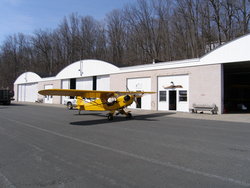 The offices of Andover Flight at Aeroflex with their J-3 parked out front. If you can't afford to fly the Top Cub, check out the J-3 which makes for cost-effective training. |
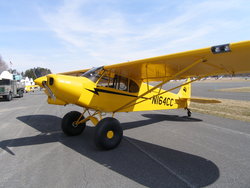 This is a 2005 model and is in remarkably good shape considering the beating it takes in the training environment. |
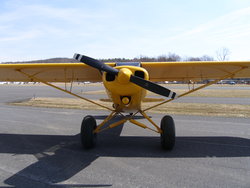 Fixed pitch prop connected to an O-360...same engine as in the 172/180 conversion, except this airplane is just a tad lighter (in spite of the tires). Climbs well. |
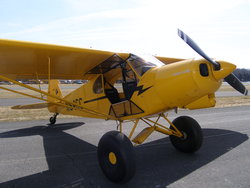 I like the fact that this cub is true to form. You can cruise with the door down and the window up and locked. We kept it closed to improve communications during the critical training period. |
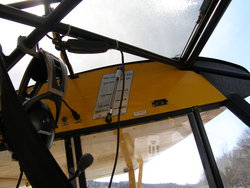 Dirt simple and reliable fuel gauges. Note that one side of the gauge is calibrated for the deck angle on the ground vs. in flight. |
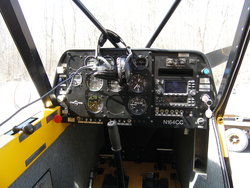 This isn't your father's J-3 panel. A full complment of gauges, though truthfully I didn't use any of them other than the airspeed and tach. The EI gauges suck because the leds aren't readable in sunlight. |
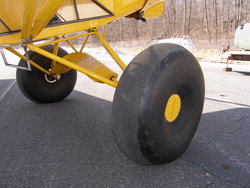 Want to land in less than hospitable areas? Time to equip the airplane with tundra tires. Trivia: these tires have so much mass they rotate after takeoff until reaching 1000 feet AGL or more! |
Did you like this article? |
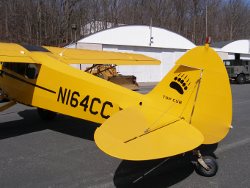 Large control surfaces translate into effective and sometimes sensitive controls. Notice the flying tail -- the entire horizontal stabilizer moves in response to pitch trim changes. We won't be going Mach 1 but it sure helps reduce drag! |
Conclusion
If you're looking to spice up your next flight review, get a tailwheel endorsement, or just fly some unique aircraft, give Damian a call and tell him Doug Vetter of dvatp.com sent you! Disclosure: I don't get any kickbacks from him....I'm just a satisifed customer. And yes, I'm going back for additional training just for the fun of it! Hope to see you up there!
P.S. Watch for the scene in Six Days when Harrison lands the beaver and swings the tail around on the grass strip. That's really him flying (not a stunt pilot) with the real actors (not doubles) on board. Somehow they managed to get approval from the production insurance company to do that. Pretty good testament to Harrison's flying skills and Damian's instruction, doncha think?



